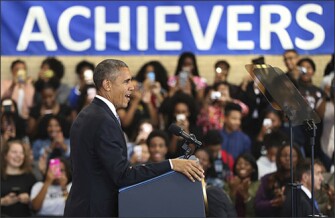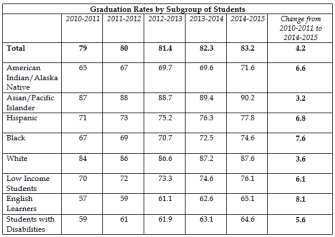
UPDATED
High school graduation rates inched up for the fourth year in a row, by nearly one percentage point to 83.2 percent in the 2014-15 school year, the Obama administration announced Monday. And while there are still significant graduation gaps between black, Hispanic, and Native American students and their white and Asian peers, those gaps are slowly closing.
Graduation rates have now risen for students overall from 79 percent in the 2010-11 school year--the first year all states used the same method to calculate graduation rates. But over that same period graduation rates for black students rose even faster, by 7.6 percent. And graduation rates for Hispanic students grew by 6.8 percent. What’s more, the rates for English-language learners, students in special education, and disadvantaged students also grew faster than for students overall.
Check out the table below for a full breakdown.

Graduation rates also increased in nearly every state. The most significant increases between the 2010-11 and the 2014-15 school years appears to have been in Alabama, which saw an increase from 72 percent--below the national average--to 89.3 percent, above the national average. And all but two states, Arizona and Wyoming, saw increases in their graduation rates of at least 1 percent since 2010-11.
Alaska, Georgia, the District of Columbia, Nevada, Utah, and West Virginia had increases of more than 10 percentage points. Iowa, Texas, and Nebraska have maintained high graduation rates between 2010-11 and 2014-15. Meanwhile, Arizona’s rate slipped from 78 percent to 75.7 percent over the same period. More in this state-by-state graduation rate breakdown.
President Barack Obama appears to be using this graduation rate announcement to take an education victory lap. The president gave a speech Monday at Benjamin Banneker Academic High School in Washington, D.C., talking about the impact of his education policies on students from early childhood onward.
“Some of the changes we made were hard, and some of them were controversial,” Obama said. “But the hard work we put in across the country has started to pay off.”

In particular, he talked about the administration’s push to increase investments in early-childhood education. He name-checked Race to the Top, which he said inspired states to raise standards. He said the U.S. Department of Education has invested in teacher training, recruitment and retention. And he talked about the administration’s moves to improve college access, including allowing students to borrow directly from the U.S. Treasury, rather than using subsidized lenders.
So are the Obama administration’s policies--like Common Core State Standards and dramatic school turnarounds--responsible for the uptick in graduation rates? There’s really no way to say for sure one way or the other, experts have told us.
For instance, Laura Hamilton, the associate director of RAND Education, a research organization in Santa Monica, Calif., said that it’s tough to claim that increases or changes in graduation rates are the result of any particular policy, either at the state or federal level.
“A number of factors could be leading to this ... I do think it’s good news. It’s definitely a trend we want to see.” But she added, “We need more evidence before we can attribute it to any particular administration or to state or federal dollars.”
In fact, she said, it’s just as possible that the graduation increase could be a by-product of the No Child Left Behind Act, which was replaced late last year with the Every Students Succeeds Act.
Other analysts had a similar take.
“It’s close to impossible to make a casual attribution about nationwide trends when so many different things are happening at once,” said Brian Gill, a senior fellow at Mathematica, a policy research organization based in Princeton, N.J.
It’s possible, he said, that some of the Obama administration’s policies - like pouring more than $7 billion into low-performing schools, including so-called “drop-out factories,” or encouraging states to establish so-called “early warning systems"- helped bolster graduation rates.
But it’s also possible that any one of a number of other factors could be the driving force, including decreases in violent crime, drug abuse, and teen pregnancy.
Prepared for Post-Secondary?
What’s more, it’s not clear if higher graduation rates necessarily mean that more students are leaving high school prepared for college, Hamilton said.
“Lots of kids graduate and go onto postsecondary education and need a lot of remedial coursework,” she added. “We also want some assurances that we are seeing increases in skills and knowledge.”
A high school diploma doesn’t necessarily mean that a student is prepared for postsecondary work, agreed Mike Cohen, the president of Achieve, a non-profit organization in Washington that helps states set expectations for what students need to know and be able to do to be prepared for postsecondary success. Roughly a third of first-year college students take remedial courses that teach them skills that they should have learned high school, he said. And those students are half as likely to earn a degree as their better-prepared peers are.
What’s more, so-called “credit recovery” courses—in which students can earn credit on a compressed time frame by demonstrating their knowledge—appear to have gained in popularity in recent years, Cohen said. But it’s tough to get a handle on what’s happening in them, he said.
“In some cases this may be a perfectly legitimate solution for allowing kids to demonstrate that they’ve met the requirements” for a particular course, “But in other cases it could lowering the bar. We simply don’t know,” Cohen said.
NAEP Connection
And there’s something else to consider: Even though the news about graduation rates has been positive, the Obama administration’s tenure also saw the first drop in 4th and 8th reading and math scores on the National Assessment of Educational Progress, or the nation’s report card, in more than two decades. Last year, when that data was released, administration officials, including former U.S. Secretary of Education Arne Duncan, warned about drawing too many conclusions from a single year of NAEP results.
For his part, U.S. Secretary of Education John B. King Jr. acknowledged on a call with reporters that there may be variation in what a high school diploma means from one place to another. But he said getting a diploma can open doors for students.
And he disputed the contention that the administration is taking credit for the nation’s progress on graduation rates, even though the news was announced in conjunction with a splashy presidential speech. The credit, he said, goes to teachers, students, and local and state educational leaders.
President Barack Obama speaks at the Benjamin Banneker Academic High School in Washington on Oct. 17, to highlight the progress his administration has made over the last eight years to improve high school graduation rates across the country.--Manuel Balce Ceneta/AP
